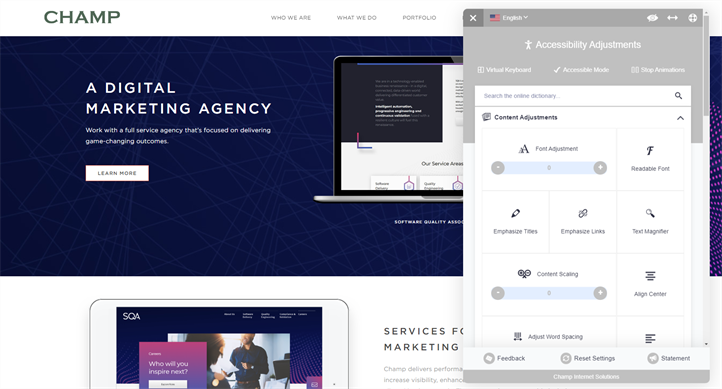As industry standards evolve, more and more businesses are not only striving, but expected, to be accessible to users everywhere. With a proactive approach,
your company can not only be exemplified from aggregations of complaints, but can grow and demonstrate its commitment to serving the public in its
entirety.
What is ADA?
The Americans with Disabilities Act (ADA), is a federal law that took into effect in 1992, declaring the necessity of “a clear and comprehensive national
mandate for the elimination of discrimination against individuals with disabilities” (42 USC § 12101(b)(1)).
The act requires places of public accommodation operated by private entities to be designed, constructed, and altered in compliance with its accessibility
standards. In 2010, the ADA Standards for Accessible Design expanded context to be applicable to a business’ online presence. These standards require
companies to offer and maintain sites that people with disabilities can use and access.
How has it evolved?
Since 2010, the waters of ADA compliance have been muddy, and lack of specificity has enabled most businesses to ignore compliance standards – until now.
Lawsuits over websites not being ADA compliant are being filed by the stackfull – and against big names. Chick-fil-A, Home Depot, and Sephora are a
few to mention, but small businesses are being targeted just the same. Legal experts speculate many of these lawsuits are taking advantage of the ignorance
of small business owners who were unaware that they were doing anything wrong. The plaintiffs typically sue before reaching out to the business and
asking for compliance – not giving them a chance to improve their websites or be made aware in advance. In most cases, rather than put up with an arduous
lawsuit, businesses will pay off the aggressors to avoid going to court.
Making matters more complicated, regulations around ADA compliance and websites still yet to remain crystal clear. What is clear, however, is that courts
require Web Content Accessibility Guidelines to be followed. Under these regulations, content
must be coded for audio translation by screen-reader software.

What action should websites take?
Take a proactive approach and invest in making your website ADA compliant. Prevent the worst case scenario lawsuits from being detrimental to your business
by never getting on the radar of opportunist lawsuit seekers. Show the public that you are dedicated to making your business offering accessible to
everyone.
Interested in making your website ADA compliant?
Reach out to us, and we’ll work with you on a solution.
